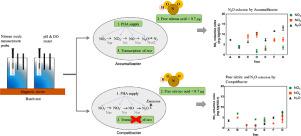Water Research ( IF 11.4 ) Pub Date : 2020-10-26 , DOI: 10.1016/j.watres.2020.116557 Samarpita Roy , Pradhan Nirakar , N.G. How Yong , Wuertz Stefan

|
Denitrifying phosphorus removal is a cost and energy efficient treatment technology that relies on polyphosphate accumulating organisms (DPAOs) utilizing nitrate or nitrite as terminal electron acceptor. Denitrification is a multistep process, but many organisms do not possess the complete pathway, leading to the accumulation of intermediates such as nitrous oxide (N2O), a potent greenhouse gas and ozone depleting substance. Candidatus Accumulibacter organisms are prevalent in denitrifying phosphorus removal processes and, according to genomic analyses, appear to vary in their denitrification abilities based on their lineage. Denitrification kinetics and nitrous oxide accumulation in the absence of inhibition from free nitrous acid is a strong indicator of denitrification capabilities of Accumulibacter exposed long-term to nitrate or nitrite as electron acceptor. Thus, we investigated the preferential use of the nitrogen oxides involved in denitrification and nitrous oxide accumulation in two enrichments of Accumulibacter and a competitor – the glycogen accumulating organism Candidatus Competibacter. We modified a metabolic model to predict phosphorus removal and denitrification rates when nitrate, nitrite or N2O were added as electron acceptors in different combinations. Unlike previous studies, no N2O accumulation was observed for Accumulibacter in the presence of multiple electron acceptors. Electron competition did not limit denitrification kinetics or lead to N2O accumulation in Accumulibacter or Competibacter. Despite the presence of sufficient internal storage polymers (polyhydroxyalkanoates, or PHA) as energy source for each denitrification step, the extent of denitrification observed was dependent on the dominant organism in the enrichment. Accumulibacter showed complete denitrification, whereas Competibacter denitrification was limited to reduction of nitrate to nitrite. These findings indicate that DPAOs can contribute to lowering N2O emissions in the presence of multiple electron acceptors under partial nitritation conditions.
中文翻译:

反硝化动力学表明一氧化二氮的吸收不受积累细菌中电子竞争的影响
脱氮除磷是一种经济高效的处理技术,它依赖于利用硝酸盐或亚硝酸盐作为末端电子受体的聚磷酸盐累积生物(DPAO)。反硝化是一个多步骤过程,但是许多生物不具备完整的途径,导致诸如氧化亚氮(N 2 O),有效的温室气体和消耗臭氧层物质等中间体的积累。念珠菌属积累细菌在反硝化除磷过程中很普遍,根据基因组分析,其反硝化能力似乎因其谱系而异。在没有游离亚硝酸抑制的情况下,反硝化动力学和一氧化二氮积累是长期暴露于硝酸盐或亚硝酸盐作为电子受体的Accumulibacter的反硝化能力的有力指标。因此,我们调查了两种富集的Accumulibacter和竞争对手(糖原积累生物念珠菌Candidatus Competibacter)对反硝化和一氧化二氮积累中氮氧化物的优先使用。我们修改了代谢模型,以预测硝酸盐,亚硝酸盐或N 2时磷的去除和反硝化速率以不同的组合形式添加O作为电子受体。与以前的研究不同,在存在多个电子受体的情况下,没有观察到积累细菌的N 2 O积累。电子竞争不会限制反硝化动力学或导致N 2 O积累在Accumulibacter或Competibacter中。尽管存在足够的内部存储聚合物(聚羟基链烷酸酯或PHA)作为每个反硝化步骤的能源,但观察到的反硝化程度取决于浓缩中的优势生物。累积细菌显示出完全反硝化作用,而竞争杆菌的反硝化作用仅限于将硝酸盐还原为亚硝酸盐。这些发现表明,DPAOs可以降低N 2在部分硝化条件下存在多个电子受体时的O排放。











































 京公网安备 11010802027423号
京公网安备 11010802027423号